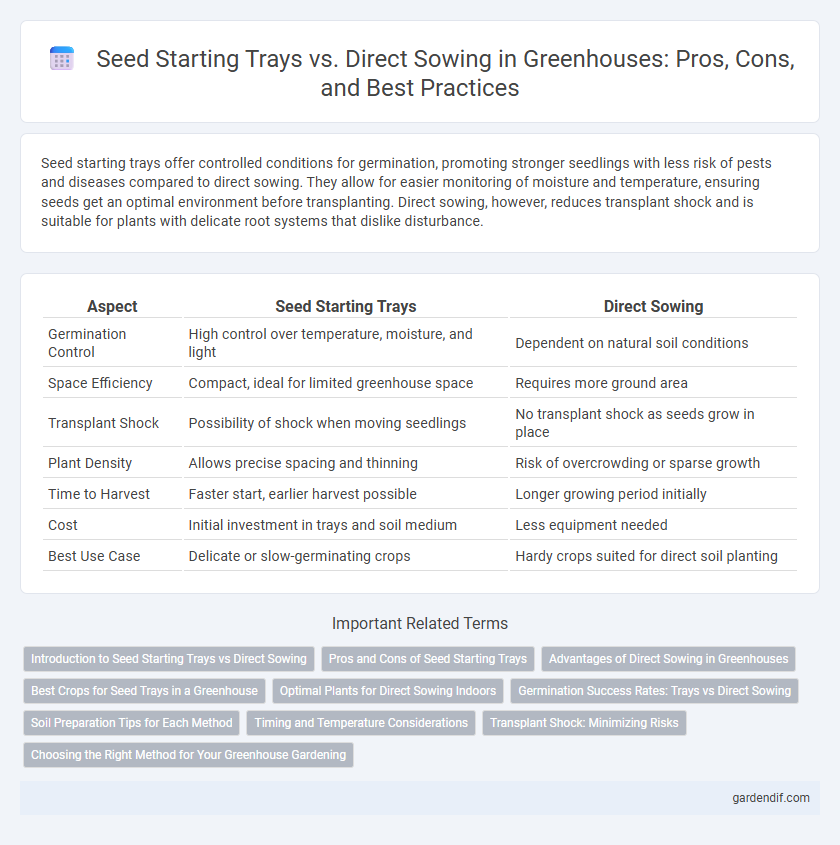
Seed starting trays vs direct sowing Illustration
Seed starting trays offer controlled conditions for germination, promoting stronger seedlings with less risk of pests and diseases compared to direct sowing. They allow for easier monitoring of moisture and temperature, ensuring seeds get an optimal environment before transplanting. Direct sowing, however, reduces transplant shock and is suitable for plants with delicate root systems that dislike disturbance.
Table of Comparison
| Aspect | Seed Starting Trays | Direct Sowing |
|---|---|---|
| Germination Control | High control over temperature, moisture, and light | Dependent on natural soil conditions |
| Space Efficiency | Compact, ideal for limited greenhouse space | Requires more ground area |
| Transplant Shock | Possibility of shock when moving seedlings | No transplant shock as seeds grow in place |
| Plant Density | Allows precise spacing and thinning | Risk of overcrowding or sparse growth |
| Time to Harvest | Faster start, earlier harvest possible | Longer growing period initially |
| Cost | Initial investment in trays and soil medium | Less equipment needed |
| Best Use Case | Delicate or slow-germinating crops | Hardy crops suited for direct soil planting |
Introduction to Seed Starting Trays vs Direct Sowing
Seed starting trays provide a controlled environment for germination, optimizing moisture retention and temperature consistency to improve seedling success rates. Direct sowing places seeds directly into the soil, offering natural conditions that reduce transplant shock but depend heavily on soil quality and weather. Choosing between these methods depends on the plant species, climate, and available resources for managing early growth stages.
Pros and Cons of Seed Starting Trays
Seed starting trays offer controlled environments for germination, promoting uniform seedling growth and reducing transplant shock. They allow for efficient space management and disease control but require additional effort for transplanting and may limit root development if seedlings are left too long. Compared to direct sowing, seed starting trays provide better early-stage protection yet involve extra costs and labor for potting and maintenance.
Advantages of Direct Sowing in Greenhouses
Direct sowing in greenhouses promotes stronger root systems by allowing seeds to grow undisturbed in their final location, enhancing plant resilience and reducing transplant shock. This method saves time and labor by eliminating the need for transplanting seedlings from trays, fostering more efficient space utilization within the greenhouse. Direct sowing also supports better soil health management, as seedlings develop in consistent conditions tailored to their specific growth requirements.
Best Crops for Seed Trays in a Greenhouse
Seed starting trays in a greenhouse are ideal for delicate crops like tomatoes, peppers, and lettuces, providing controlled environment conditions for germination and early growth. Direct sowing suits root vegetables like carrots and beets that prefer minimal disturbance, but these crops generally benefit less from greenhouse seed trays. Utilizing seed trays maximizes space efficiency and improves seedling survival rates for heat-loving and slow-germinating crops, making them the best choice in greenhouse seed starting.
Optimal Plants for Direct Sowing Indoors
Direct sowing indoors is ideal for plants like carrots, radishes, and lettuces that have delicate root systems and dislike transplanting. Seed starting trays work best for tomatoes, peppers, and eggplants which require controlled conditions and a longer germination period. Choosing the right method enhances germination rates, ensuring healthy, vigorous seedlings adapted for greenhouse cultivation.
Germination Success Rates: Trays vs Direct Sowing
Seed starting trays offer higher germination success rates compared to direct sowing due to controlled temperature, moisture retention, and protection from pests. Trays enable uniform seed spacing and easier monitoring, reducing seedling loss and promoting stronger root development. Direct sowing often results in uneven germination and higher seed predation risk, making trays a preferred choice for consistent crop establishment.
Soil Preparation Tips for Each Method
Seed starting trays require a well-draining, sterile seed-starting mix rich in organic matter to promote healthy root development, ensuring a controlled environment free from pathogens. Direct sowing benefits from soil that is loosened to at least 6-8 inches, enriched with compost to enhance fertility and moisture retention, and free of large clumps or debris to facilitate seed-to-soil contact. Both methods require consistent moisture levels and proper pH balance, typically between 6.0 and 7.0, to optimize germination and early seedling growth in greenhouse conditions.
Timing and Temperature Considerations
Seed starting trays allow precise control over timing and temperature, enabling gardeners to begin germination indoors weeks before outdoor conditions become favorable. Direct sowing depends heavily on soil temperature, which must consistently reach species-specific thresholds to ensure successful sprouting. Utilizing trays with heat mats can optimize seedling development by maintaining stable warmth, crucial during early spring or cool climates.
Transplant Shock: Minimizing Risks
Seed starting trays provide a controlled environment that reduces transplant shock by promoting strong root development before seedlings are moved to the greenhouse soil. Direct sowing eliminates transplant shock but demands optimal conditions for seed germination and early growth, which can be inconsistent. Using seed trays with quality potting mix enhances root access to moisture and nutrients, minimizing stress during transplantation.
Choosing the Right Method for Your Greenhouse Gardening
Seed starting trays offer controlled conditions for germination, enhancing seedling growth and reducing transplant shock in greenhouse gardening. Direct sowing simplifies the process by planting seeds directly into the soil, saving time and allowing roots to establish naturally. Selecting the method depends on factors like plant species, greenhouse climate control, and desired growth speed to optimize yield and health.
Seed starting trays vs direct sowing Infographic

 gardendif.com
gardendif.com